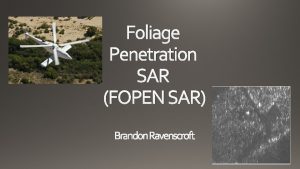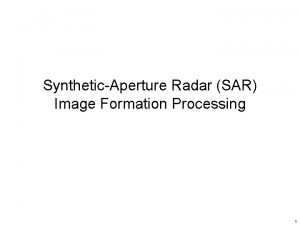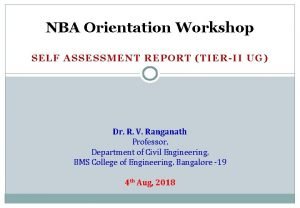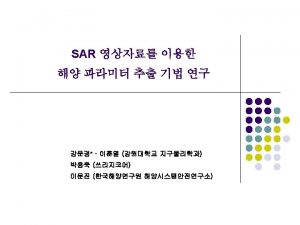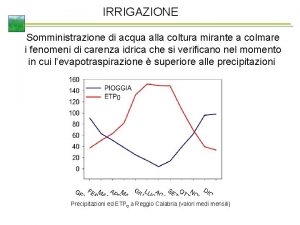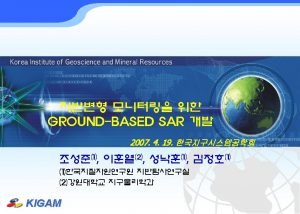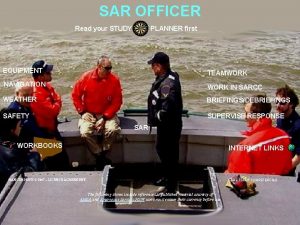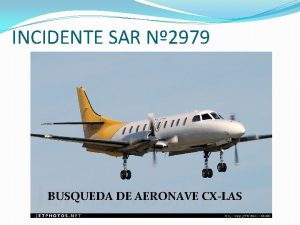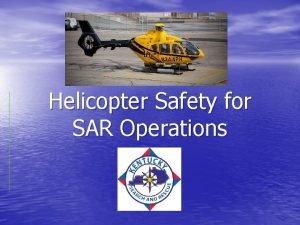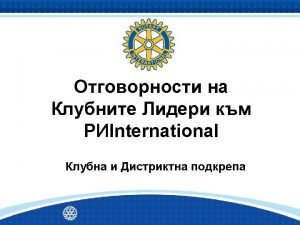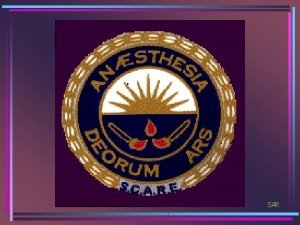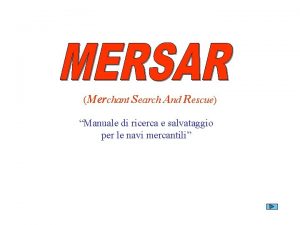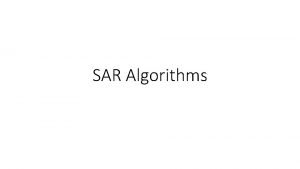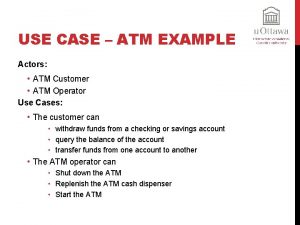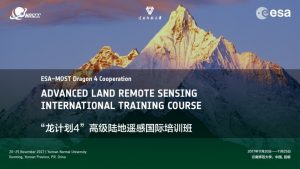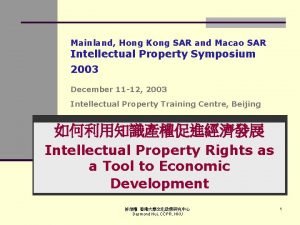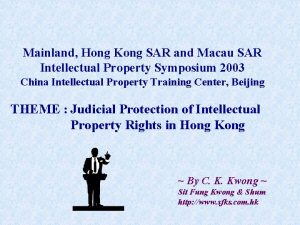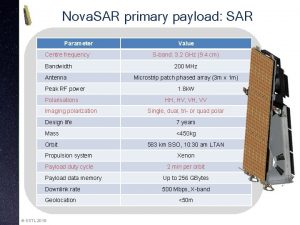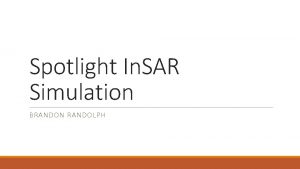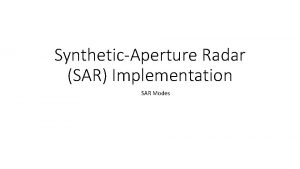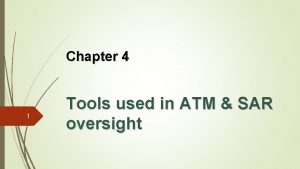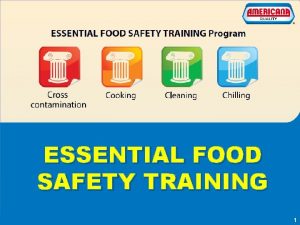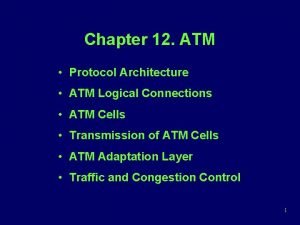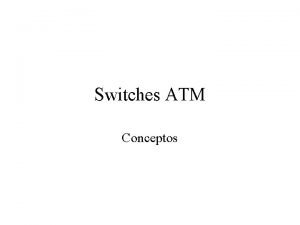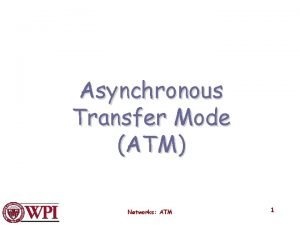Chapter 3 1 ATM Safety Essential ATM SAR









































- Slides: 41

Chapter 3 1 ATM Safety, Essential ATM & SAR Oversight Responsibilities and Inspector Qualifications

2 Objectives At the end of this course the participant should be able to: Describe the functions of an ATM/SAR oversight organization; Demonstrate an understanding of State safety management responsibilities; Highlight an ATM/SAR inspector’s role within the ATM oversight organization; State the duties and responsibilities an ATM/SAR inspector; Describe the required ATM & SAR inspector training and competencies; Develop safety oversight tools for oversight of ATM & SAR providers; Perform an audit of an ATS & SAR service provider; Write and disseminate an audit report; List requirements for licensing/Competency of ATM personnel; Describe reviews and approvals of proposed changes to the airspace system; Develop technical guidance material.

3 Introduction An ATM/SAR inspector is a qualified person authorized by the State to carry out safety oversight activities over ATM & SAR providers. Safety oversight is a function performed by a State to ensure that individuals and organizations performing an aviation activity comply with safety-related national laws and regulations. To effectively fulfil its oversight responsibilities, a State civil aviation system needs to be: Ø properly organized, and; Ø staffed with qualified personnel capable of accomplishing the required wide range of technical duties involved in safety oversight.

4 Introduction The State delegates specific powers of authority to Inspectors to support the accomplishment of their tasks. Some States have included the power of authority and degree of accountability into aviation law to enable auditors and inspectors to effectively carry out their assignments. It is also necessary that States create favorable conditions that allow oversight inspectors and auditors to discharge their duties. These include: a) Establishment of clear and comprehensive workplace policies and procedures; b) Provision of a safe working environment; and c) Supplying inspectors and auditors with adequate workplace resources.

5 Introduction ATM & SAR Inspectors Qualification Criteria; States define qualification criteria for their ATM & SAR auditors/inspectors so as to ensure an appropriate level of knowledge, training, experience and competency, covering at minimum, the following aspects: Ø knowledge and understanding of the requirements against which audits and inspections are to be performed; Ø techniques of examining, observing, interviewing, evaluating and reporting; Ø skills required for managing an audit/ inspection such as planning, organizing, communicating, documenting and directing Ø competency of auditors/inspectors that should be evaluated on a regular basis.

6 Basic Requirements for ATM & SAR Safety Oversight Inspectors ATM & SAR auditors/inspectors should have a full understanding of: Ø Relevant Standards and Recommended Practices (SARPs); Ø Applicable State specific regulations; Ø Procedures for Air Navigation Services (PANS); Ø Safe operating practices and; Ø Human Factors principles.

7 ATM & SAR Inspector Qualification Requirements ATM & SAR Auditors/inspectors should have the necessary skills and knowledge to conduct the audits/inspections in a satisfactory manner and achieve the expected results; The auditors/inspectors should be knowledgeable on audit principles, procedures and methods (Audit Techniques); Auditors/inspectors should be able to comprehend the audit scope and apply audit criteria; Ø Audit criteria are policies, procedures, or requirements used as a reference against which audit evidence is compared. The auditors/inspectors should be aware of, and be able to work within an organization's legal and contractual requirements; ATM & SAR Auditors/inspectors should have achieved competency through formal education, training programmes, relevant technical experience, and audit experience.

8 Roles of an ATM & SAR Oversight Organization q The ATM/SAR oversight organization supports the State in achieving its oversight mandate. q Essential safety oversight roles of an ATS oversight organization include: ü Establishing State safety standards and approving ANSP Safety Management Systems; ü Monitoring compliance with safety standards and SMS through routinely and objectively auditing and inspecting ANSPs, including their functions, personnel, safety risk management, and safety assurance;

9 Roles of an ATM & SAR Oversight Organization ü Putting systems in place to license/certify/approve/rate ATS personnel (as applicable); ü Establishing, inspecting, and periodically renewing all ATS licenses, certifications, approvals, and ratings; ü Monitoring the ATS & SAR service providers’ corrective actions and continuous safety improvement; ü Providing On-job training to ATS oversight organization technical personnel; ü Certificating ANSPs (as applicable).

10 Inspector Duties and responsibilities Inspectors’ duties will keep evolving in order to adapt to the changing regulatory environment and the specific needs of their oversight organization. As a consequence, it is not possible to identify a standardized list of tasks for ATM and SAR inspectors applicable to all States as these are specific to the structure and the context of the oversight organization in individual States. The principal operational duties of ATM/SAR inspectors will normally be focused on inspection, certification and on-going surveillance.

11 Duties of an ATM Inspector q An ATM & SAR inspector’s essential responsibility is to perform oversight of ANSP compliance with: ü applicable regulations, ü standards, ü Procedures, and; ü its SMS. q For an Air Traffic Services Safety Inspector, typical duties may include one or more of the following:

12 General Duties of an ATM/SAR Inspector Oversight of air traffic services providers, including acceptance of their SMS; Reviewing proposed changes to ATS systems and procedures, including safety assessments and changes to the ANSP’s manual e. g. MANSOPS, SMS manual etc. ; Continuously monitoring the airspace system; Analyzing safety data for trends or hazards e. g. incident reports etc. ; Participating in audits and inspections of ANSPs; Approval of air traffic control training organizations and Training programmes;

13 General Duties of an ATM/SAR Inspector Approval of other air traffic services training programmes; Oversight of search and rescue coordination Qualification and approval of air traffic control simulation training devices; Assessment of applicants for an air traffic controller licence or rating (or equivalent qualification); Management of records and documents; and Supervise OJT for newly recruited ATM inspectors.

14 Duties and responsibilities of ATM/SAR Inspectors 1. Surveillance Monitor the performance of the Air Traffic Services System to ensure compliance with promulgated standards; Conduct regular audits/inspections to ensure compliance in the provision of Air Traffic Services, Flight Procedure Design and Search and Rescue; Ensure all Air Traffic Controllers involved in the provision of Air Traffic Control Services have valid Air Traffic Control licenses in accordance with applicable regulations; Obtain regular progress reports on the conduct of training for the air traffic controllers; Review ANSPs Manuals of ATM & SAR Operations or other relevant documents and recommend for approval or amendments thereto;

15 1. Duties and responsibilities of ATM/SAR Inspectors Surveillance Cont. Conduct/Oversee controller competency assessments; Evaluate ATS & SAR training programmes to ensure that training provided addresses the needs for safety and efficiency in the provision of air traffic services; Follow up on administrative processes involved in issuing and endorsing ATC licenses and monitor the validity of individual licenses; Evaluate and recommend for approval visual/instrument flight procedures; Investigate ATS incidents and report non-compliance with regulations and procedures; and, Assist in aircraft accident investigation.

16 Duties and responsibilities of ATM/SAR Inspectors 2. Regulation Transpose ICAO standards into State specific regulations; Develop/review guidance material as may be necessary to facilitate the implementation of standards; Recommend enforcement action for non-compliant ANSPs Review existing legislation/regulations and recommend amendments thereto; Evaluate ANSP applications and recommend for certification; Liaise with ANSPs on regulatory matters associated with the provision of Air Traffic Services; Analyse ICAO State letters and recommend appropriate action.

17 Responsibilities of ATM/SAR Inspectors In a nutshell ATM & SAR inspectors: Carry out efficient and effective safety oversight activities of Air Traffic Management system, Search and Rescue and Flight Procedure Design with the objective of: Ø enhancing safety, efficiency and regularity of air navigation and; Ø ensuring compliance with Civil Aviation Regulations and Standards; Develop technical guidance materials to enable effective implementation of Civil Aviation Regulations, Technical guidance material and Manual of ANS Standards;

18 Responsibilities of ATM/SAR Inspectors Recommend changes to civil aviation legislation and regulations as may be appropriate. Recommend enforcement action with regard to non-compliances to provisions of ICAO standards and procedures, legislation and state regulations the failure of which may endanger safety of air operations and property

19 ATM & SAR Inspector Training and Competencies International aviation standards require that the CAA provides its safety inspectors with comprehensive training to ensure that they are adequately qualified to perform their duties. The training objective is to provide the ATM & SAR Inspectors with knowledge and skill to enable them perform ATM & SAR regulatory functions. This knowledge is acquired through a combination of: 1) formal training courses, and; 2) on-the-job training.

20 ATM & SAR Inspector Training and Competencies To ensure that technical personnel receive the required training in an effective manner and maintain their competency, The State should; 1) Establish a robust training system, and; 2) Implement the system and its programs. This system should be based on a documented training policy established and signed at the management level of the State authorities. A CAA training policy should clearly address the initial training of inspectors, as well as the periodic recurrent and specialized training necessary for the inspectors to perform the tasks for which they are responsible.

21 ATM & SAR Inspector Training and Competencies The training policy should commit to provide all necessary training to all regulatory technical personnel in all areas, including: indoctrination; initial training (e. g. induction and basic training); specialized; on-the-job training (OJT); recurrent training, and; advanced training.

22 ATM & SAR Inspector Training and Competencies The training policy should provide for development of a Training programme for ATM and SAR safety inspectors so as to meet the requirements of CE 4 of an effective safety oversight system. In the training programme, subjects of regulatory functions and specialized areas should be meshed in order to provide overall skill and knowledge to the inspectors so as to meet the intent of the following objectives: Ø Instilling knowledge and ethics regarding the overall functioning of the oversight organization and the regulatory framework. Ø Familiarizing ATM & SAR inspectors with authenticated knowledge, procedures and practices required at various level of functioning. Ø Bringing the knowledge and understanding of inspectors into a common standard.

23 ATM & SAR Inspector Training and Competencies Ø Enabling the inspectors to take various decisions in their area of work. Ø Empowering the safety inspectors with international best practices followed by other ATM & SAR regulatory authorities. Ø Providing guidance for technical documentation and record keeping. Ø Orientating the inspectors towards their functioning in their specific oversight area. Ø Optimizing resources and management of work. Ø Developing skill and confidence through a structured On-Job Training (OJT) so as to enable the inspectors work independently and in teams. Ø Improving the overall personality of inspectors.

24 ATM & SAR Inspector Training and Competencies q The training policy should provide for the establishment of: Ø a training programme for each technical staff position and; Ø training plans for each technical staff member. q As a principle, an ATM/SAR inspector can only be authorized to perform safety oversight duties in the area or subject where; Ø the inspector/auditor has satisfactorily completed the required training and; Ø maintains the required competence.

25 ATM & SAR Inspector Training and Competencies Training of the State’s technical personnel is not limited to strictly professional elements, such as the maintenance of competency and currency only but should include a wide range of relevant topics. It is essential that civil aviation inspectors also be provided with training on other subjects such as; v applicable CAA regulations, v inspectors’ skills, knowledge, duties and responsibilities, and; v CAA procedures for the implementation and enforcement of requirements.

26 ATM & SAR Inspector Training and Competencies 1. Initial training q The basic component of initial training should address the following topics: departmental ethics/conduct and discipline; security aspects of the safety inspector’s work; the role of safety oversight inspectors, their codified level of authority and degree of responsibility; overview of CAA-regulated entities and associated challenges; basics of human factors;

27 ATM & SAR Inspector Training and Competencies 1. Basic components of initial training Cont. certification and authorization policies, processes and procedures; surveillance and inspection policies, processes and procedures; audit policies, processes, and procedures; investigations and enforcement policies, processes and procedures; risk assessments; State safety programme (SSP); safety management systems (SMS); Quality assurance

28 ATM & SAR Inspector Training and Competencies 2. Specialized Training q The purpose of specialized training is to upgrade the knowledge and competency of inspectors to be at par with international standards and for efficient functioning. q During specialization training, Safety inspector candidates apply the knowledge and skills acquired during the basic phase. q Often this can best be accomplished by introducing realistic, but hypothetical, scenario-based exercises.

29 ATM & SAR Inspector Training and Competencies 2. Specialized Training Cont. Example of specialized training ATM & SAR inspector candidates could demonstrate the knowledge and skills required to perform one or a combination of the following duties and tasks: ü review and approve manuals; ü approve training programmes; ü conduct an inspection; ü conduct a realistic risk assessment; ü assess an SMS q During specialization training, the instructor should assess if the trainees demonstrate all the competencies at the level determined by the CAA.

30 Additional Training for ATM/SAR Inspectors 3. Recurrent training To ensure that ATM & SAR inspectors maintain competency, proficiency and keep current on latest techniques, procedures and new developments in their respective areas of expertise, it is essential that they receive periodic recurrent training. 4. Training for re-qualification An Inspector who has been out of the programme for a period specified by the State: a) Shall undertake a recurrent training, and b) Conduct at least two inspections accompanied by a lead Inspector

31 ATM & SAR Inspector Training and Competencies 5. Advanced Training The goal of advanced training is to enhance the competencies of experienced inspectors so they can effectively address challenging and complex oversight issues. Training in the following areas can support the acquisition of competencies that inspectors should demonstrate as senior inspectors: Ø programme management; Ø organizational cultures and change management; Ø quality management system implementation and audit techniques; Ø dispute resolution; Ø root cause analysis; Ø corrective and preventive action plans; and Ø conducting investigations and enforcement procedures.

32 ATM & SAR Inspector Training and Competencies On-job Training Technical personnel should satisfactorily complete OJT before being assigned safety oversight-related tasks and responsibilities. OJT for ATM/SAR inspectors should; 1) be provided by experienced, senior ATM/SAR inspector as appropriate; and, 2) follow a structured program that includes observing as the qualified inspector carries out oversight activities, working under supervision, competence assessment and authorization, etc.

33 ATM & SAR Inspector Training and Competencies On-job Training Cont. It is important to ensure that ATM/SAR auditors/inspectors are only authorized to perform tasks after having been assessed as qualified. The completion of the OJT, including the competency assessment, should be properly documented. The CAA shall keep and maintain all the training records of all Inspectors.

34 ATM & SAR Inspector Training and Competencies On-job Training Cont. All ATM/SAR Inspector/auditor candidates shall undergo OJT under the supervision of a qualified ANS Inspector. The candidate must, a) first participate in the number of inspections specified in the training program while observing a qualified ANS Inspector conduct the audits; and, b) personally conduct the number of inspections specified in the training program under the supervision of an experienced and credentialed ANS Inspector.

35 Continued Inspector Qualifications After completion of on-the job training, ATM & SAR inspectors will be issued with a certificate or license which authorizes them to perform inspections, investigations and audits to determine air traffic service providers’ compliance with requirements. In order to receive and maintain an ATM & SAR inspector certificate/license, the ATM & SAR inspector must: Ø Satisfactorily complete initial and recurrent training; Ø Complete on-the job training; and Ø Participate in the number of audits/inspections determined by the State over a specified period of time (Remain current in practice).

36 ATM/SAR Inspectors Attributes Ethical conduct: The inspector must be professional The Inspectors should possess a high degree of integrity, be impartial in carrying out their tasks, tactful and able to relate with people. Good management, communication and interpersonal skills. Avoid personal prejudices Manage cross-cultural differences effectively Overcome recent-action bias Avoid using personal opinion in arriving at audit conclusions

37 Inspector Competencies The oversight inspector competencies are used to reliably predict successful performance of inspectors in the performance of their duties and tasks. This is especially useful as inspectors need to adapt to a changing regulatory environment. Over the course of their careers, inspectors will find themselves in unusual and frequently complex situations. Depending upon the circumstances, they can be called upon to act as observers, analysts, investigators, auditors, mediators, negotiators, technical experts, judges or even as witnesses. Technical expertise alone does not prepare a person to function competently in such an environment.

38 The ICAO Inspector Competency Framework For these reasons, ICAO Promotes a competency framework for safety oversight inspectors. The ICAO competency frameworks are developed by ICAO and present a set of competencies for a given aviation discipline. Each competency has an associated description and observable behaviours. It is a generic blueprint to guide the development and maintenance of a strong inspectorate workforce. The ICAO Civil Aviation Safety Inspectors’ competency framework should be adapted by States to the context of the oversight organization in which the inspectors work Ref. Doc. 10070 - Manual on the Competencies of Civil Aviation Safety Inspectors chapter 3. 3.

39 Inspector Credentials The ATM/SAR Inspector’s credentials will identify the bearer as an accredited representative of the Authority authorized to perform inspections/audits and discharge those duties as provided for by the CAA. Approval Authority The CAA accounting officer is the approving authority for issuance of Inspector credentials. Responsibility The CAA is responsible for establishing the criteria for eligibility, issuance and accountability of all Inspector credentials and the procedures for issuance and control of credentials. Use of Credentials a) The credentials shall be used only in the conduct of official business b) Holders of credentials are responsible for their proper safekeeping at all times c) Misuse or improper possession of the credentials can subject the offender to disciplinary action.

40 Loss of credentials and Surrender of Credentials Loss of credentials q The ATM/SAR Inspector’s credential is the property of the Authority. q Loss of credentials should be reported to relevant security authorities immediately. Surrender of Credentials q The ATM/SAR Inspector’s credentials shall be surrendered to the holder’s supervisor under any of the following conditions: a) Termination of employment; b) Reassignment to a position which does not require an ATM/SAR Inspector’s credential; c) Issuance of a revised credential; d) Upon demand of the issuing authority; or e) Expiry of the validity period of the credential.

End of Chapter 3 41
 Sar radiation
Sar radiation Essential non essential fatty acids
Essential non essential fatty acids Lab safety essential questions
Lab safety essential questions Sar of adrenergic antagonist
Sar of adrenergic antagonist Sar of anticholinergic drugs
Sar of anticholinergic drugs Definition of sar
Definition of sar Sar soil
Sar soil Sar qsar
Sar qsar Definition of sar
Definition of sar Diagnosis banding sar
Diagnosis banding sar Sar of cephalosporins
Sar of cephalosporins Nova sar
Nova sar Sar of penicillin
Sar of penicillin Sar of penicillin
Sar of penicillin Foliage penetration
Foliage penetration Gram negative bacteria
Gram negative bacteria Lim sårskade
Lim sårskade Sar image formation
Sar image formation Leptiri na sar planini
Leptiri na sar planini Sar of cephalosporins
Sar of cephalosporins Nba sar tier ii
Nba sar tier ii Sar of cephalosporins
Sar of cephalosporins Cephalosporin
Cephalosporin Sar
Sar Durezza acqua
Durezza acqua Ipcc sar
Ipcc sar Layover
Layover Stramenopila
Stramenopila Slidetodoc.com
Slidetodoc.com Gb-sar
Gb-sar Hester turner
Hester turner Microprocessor
Microprocessor Sar officer
Sar officer Choanoflagellates supergroup
Choanoflagellates supergroup Stramenopila
Stramenopila Cxlas
Cxlas Diatoms supergroup
Diatoms supergroup Helicopter landing zone checklist
Helicopter landing zone checklist Sar rotary international
Sar rotary international Sar of sulfonamides
Sar of sulfonamides Combitubo
Combitubo Ricerca per immagini
Ricerca per immagini














